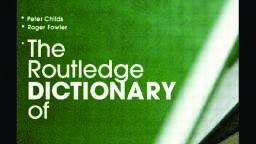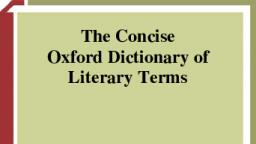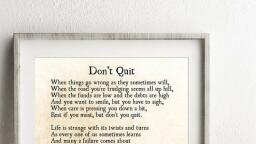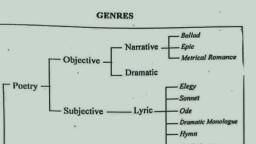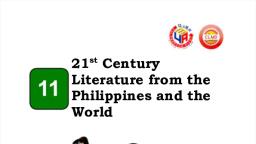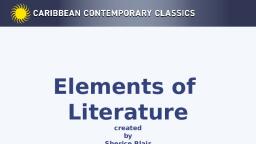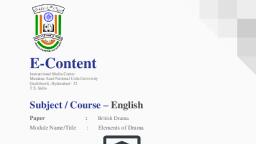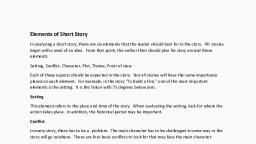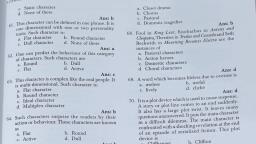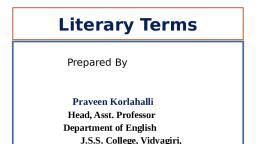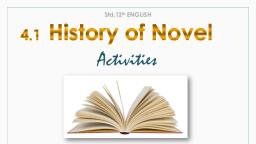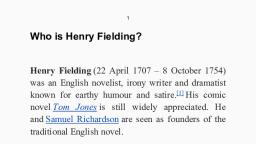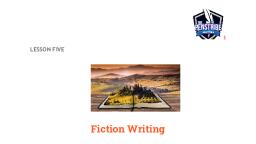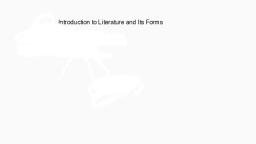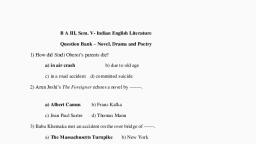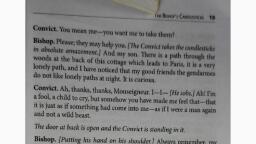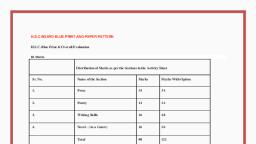Page 1 :
Elements of Literature, created , by, Sherice Blair
Page 2 :
Introduction to Prose, Prose, drama and poetry are the three main types of literature. The table below shows the main differences between them., 2
Page 3 :
Elements of Prose, Let’s look more closely at the elements of Prose:, , Characters, Plot, Setting, Narrative Techniques, Themes, 3
Page 4 :
Characters
Page 5 :
All stories have a character or characters. The author uses the character’s actions in the story as a driving force for the plot – the sequence of events., Characters in stories can be humans, animals, or inanimate objects; anything that can be described as an individual in the story. , The main character in a story is often called the ‘protagonist’. Most stories also include an ‘antagonist’, who directly or indirectly sets up conflicts, obstacles or challenges for the protagonist. We’ll look at this in more detail later., 5, Characters Explained
Page 6 :
Major Characters - These are characters that contribute significantly to the development of the plot. , The author uses their actions to drive the events of the story., These characters are often (although not always) seen or referred to frequently throughout the story. In Escape to Last Man Peak Matron is never seen, but often referred to, and Teacher Mack appears only briefly, but is quite influential on the children’s journey., 6, Major Characters
Page 7 :
Minor characters – These are characters who do NOT contribute significantly to the development of the main plot., They are often seen in short sections of the story, rather than throughout the whole story. , These characters may not even appear in person, but might simply be mentioned by other characters., Minor characters may be useful in changing the tone of the story, or diffusing tension, for example., 7, Minor Characters
Page 8 :
Who is a protagonist?, , We know that a protagonist is one of the leading characters (or group of characters) of a story or novel. As such, the protagonist is often seen as the hero, main character or narrator of the story. The protagonist is a major character., The protagonist plays an important role in the story because he/she is the character the story is based on. , In Escape to Last Man Peak the children as a group could be seen as the protagonist., 8, Protagonist
Page 9 :
Who is an Antagonist?, , Think of a character as a coin, on this coin the protagonist would be on the front of the coin and the antagonist would be on the back., Based on this example, you will realize that the Antagonist is the opposite of the Protagonist. , The Antagonist may be the villain in the story. The job of the Antagonist is to oppose the Protagonist as such often the Antagonist is seen as the enemy of the Protagonist., 9, Antagonist
Page 10 :
How does the author make the characters reveal their personality or character traits in the story?, , This process can be done through direct or indirect characterization., , Direct Characterization – This is when the author directly and clearly describes the traits and personality of the characters. , , Indirect Characterization – Here the author doesn’t tell you what the character’s traits are, but these are revealed through the character’s Speech, Thoughts, Effect on others, Actions and Looks (STEAL)., 10, Characterization
Page 11 :
A ‘round’ or ‘rounded’ character is a dynamic character who grows and changes during the course of the story., It is easier for the author to develop a round character in a novel than in a short story because of the extended nature of the work. , In Escape to Last Man Peak the children grow and develop during the course of the story, as they encounter many new experiences., 11, Round Character
Page 12 :
The opposite of a round character. A flat character does not grow or develop or change throughout the story., A flat character may be thought of as one dimensional, meaning they have no depth. , Often this type of character can be seen as being a stereotype, just representative of one type of character rather than someone capable of change and nuance., In Escape to Last Man Peak, the policeman who visits the Orphanage in the beginning of the book could be seen as a flat character., 12, Flat Character
Page 13 :
13, Self Assessment, I can define the term character., I can identify major and minor characters in a story/novel., I know the difference between flat and round characters. , I can identify examples of direct and indirect characterization.
Page 14 :
Elements of Plot
Page 15 :
The plot of the story/novel is the sequence of events that makes up the narrative. , A very common plot structure moves from the opening (exposition) through action, conflict, climax to the ending, or resolution:, 15, Plot, Exposition, Plot, Diagram, Resolution, Climax, Raising Action, Falling Action, Conflict
Page 16 :
The exposition is designed to introduce or present the story and provide information about the setting and characters. , It helps the reader to understand the context of the story. , The exposition is also helps to propel the events of the plot. , In Escape to Last Man Peak, the story opens with Nellie, the narrator, being woken up; as the story moves through the day, it introduces a lot of information about Sunrise Home and the children’s situation, and sets the scene for the whole story., 16, Exposition
Page 17 :
The conflict in the novel helps to drive the plot. It can be internal (within one character) or external., , INTERNAL CONFLICT, The character engages in a physical, mental or emotional struggle with some aspect of himself/herself., EXTERNAL CONFLICT, The character struggles with other characters., The character struggles with some aspect of nature., The character struggles with some aspect of society, for example a local community or a national government or institution., 17, Conflict
Page 18 :
The climax describes the point at which the conflict and action in the story reaches its peak., This is highest point of action in a story or novel when the reader is sitting on the edge of their seats not sure what will happen next. , In Escape to Last Man Peak, the climax could be said to be the point at which the children pass the gang of bad boys at Windsor., 18, Climax
Page 19 :
The resolution of the conflict occurs at the end of the story and shows that the conflict has come to a close, at least temporarily., The story doesn’t always tell you exactly what happens in the end, but it does come to a resolution leaving the reader with an understanding of what has happened., In Escape to Last Man Peak, the story ends at the end of the children’s journey, with them all safe at Last Man Peak, although it leaves open the question of what happens to them later., 19, Resolution
Page 20 :
20, Self Assessment, I know the elements of a story/novel., I can label elements of a story/novel., I can identify elements of a story/novel., I can identify the different types of conflicts in a story/novel.
Page 21 :
Setting, TIME, ENVIRONMENT, ATMOSPHERE, Weather
Page 22 :
Simply put, the setting is the environment in which the story takes place. , Sometimes the setting of a novel can change throughout a story. , This is seen in the novel, Escape to Last Man Peak in which the setting of the story changes as the children journey through the interior of the country., 22, Setting explained
Page 23 :
Time is an important element of setting because it frames for the reader the period in which the story is taking place. , This helps the reader to understand some of the events and issues presented. , This sets the scene historically, describing whether the story is set in the present day, or in the past, or even in the future., It also affects the pace of the story, does it describe events in a short period of time, or over many years?, 23, Time
Page 24 :
The weather describes the conditions that influence the physical environment in which the narrative is taking place., The author sometimes uses the weather to set the tone of the narrative. , In Escape to Last Man Peak, the weather is often described, because it makes a big difference to the children’s experiences and their journey., 24, Weather
Page 25 :
The atmosphere is the emotional environment or mood of the story. Atmosphere can be created by the time of day, the physical state of the environment (bright/cheerful or dull/dreary/dingy), the level of tension or safety that is felt, etc. Here is an example from Escape to Last Man Peak, as the children approach a dangerous but exciting climax:, The darkness grew intense, and the silence seemed loud all around us. Not a sound came from the river nearby, and not a breath of wind moved the leaves of the trees. The hooves of the calves and the donkey had been muffled with strips of blanket, and all of us moved silently on bare feet. The only sounds I could hear were the soft thud-thud of hooves, my own breathing, and now and then the small clatter of a stone., 25, Atmosphere
Page 26 :
Narrative Techniques
Page 27 :
Narrative techniques are the devices the author uses to convey meaning., Here are some examples:, , Point of view, Flashback, Foreshadowing , Irony, Symbols, Motifs, 27, Narrative Techniques
Page 28 :
The point of view is the perspective from which the story is written. , , The first person point of view is told from the story-teller’s (or narrator’s) perspective. The pronouns that are used include I, me, my. , , The third person point of view is told by a narrator who is not part of the story, and is not describing their own experiences. Third person pronouns include he, she, they, them, his, hers., 28, Point of View
Page 29 :
First Person Point of View, The narrator is the character telling the story. The narrator is often the protagonist of the story, telling their own story. , This means the reader only sees what the narrator sees or thinks. , Therefore, the reader might also experience the biases of the narrator., 29, Point of View
Page 30 :
When the story is told from the third person point of view the reader usually gets a broader perspective. , There may be one narrator or several narrators, but their story is not limited to what their characters actually experience in the story. They have an overview, not a partial view of the action., Let’s look at the third person point of view in more detail., 30, What is the difference between the first and third person perspective?, Third Person Point of View
Page 31 :
Third Person Limited, As the name suggests although the story is told in the third person, the narrator does not see everything, so this perspective is limited in what is presented. , , Third Person Omniscient, From this perspective the author knows and relates all the feelings, actions and events that occur in the story. , This story is told by an all-knowing (omniscient) figure., 31, Third Person Point of View
Page 32 :
Flashback is a narrative technique that shows the readers events that occurred in the past. , Flashback is used to give the reader information about events in the past, to help them understand and identify issues they encounter in the story., 32, Identify an example of flashback in a story or novel., Flashback
Page 33 :
The author sometimes provides the readers with clues/hints of events that might occur as the story or novel progresses. , For example, in Escape to Last Man Peak, the children leave Sunrise Home shortly before Christmas, and Pauline takes the Home’s Christmas decorations with her. This could be an example of foreshadowing in hinting that the children might reach safety in time for Christmas., 33, Foreshadowing
Page 34 :
There are at least three types of irony that you will find in stories; these are: , Irony, Dramatic Irony;, Situational Irony., Irony is a narrative technique that highlights the opposite of what is expected. Therefore, a situation is identified as being ironic if the final outcome is the opposite of what was expected., 34, State an instance of irony in a story/novel., Irony
Page 35 :
A symbol is something (colour, element of nature, an item, etc.) that is used to represent something else. , In Escape to Last Man Peak, Bess the dog could be said to be the symbol of strength and loyalty, guiding and guarding the children., 35, What does a white dove mean to you when you see it?, , What is this bird used to represent?, Symbols
Page 36 :
Motifs, Motifs are reoccurring ideas/events that are present throughout the story., These ideas/events are often symbolic in nature. Therefore, the author uses them to convey additional meaning. , Motifs can also add to the creation of themes in the story/novel., 36, Castillo, R., 2021. Motif In Literature. [video] Available at: <https://youtu.be/dXu4pV0Xwyw> [Accessed 5 January 2021].
Page 37 :
Theme
Page 38 :
A theme is the overall idea the author tries to convey to the reader. , Some common themes that are presented in a number of contemporary classics:, Childhood Experiences , Love and family relationships, Discrimination, Racism, Death, Friendship, 38, Theme
Page 39 :
In Escape to Last Man Peak the themes include: , Childhood experiences, Going on a journey, Working through difficulties, Friendship and caring, Family memories, , Can you think of any others?, 39, Theme
Page 40 :
40, Self Assessment, I can define the term theme, I know the types of theme, I can identify a theme in a story/novel, I can discuss themes in stories and novels




